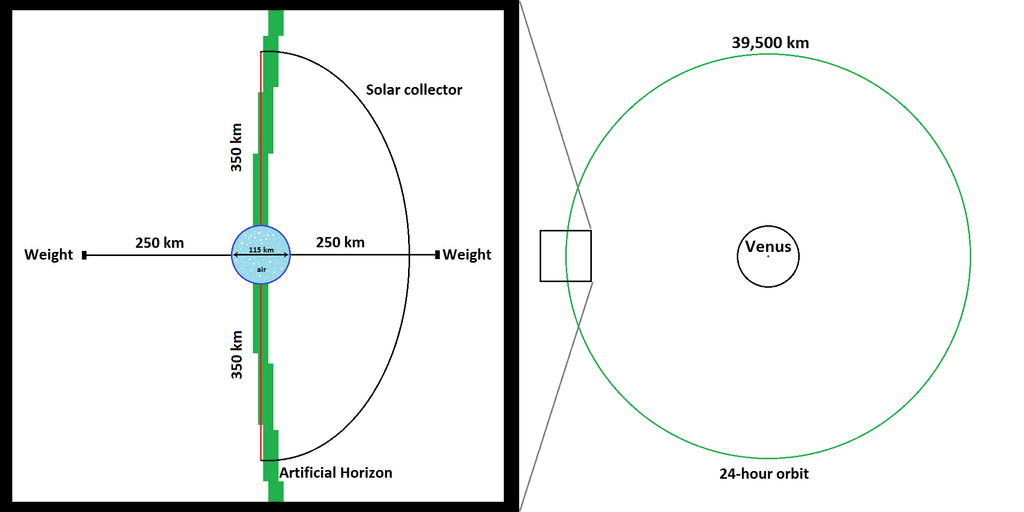New Mars Forums
You are not logged in.
- Topics: Active | Unanswered
Announcement
Pages: 1
#1 2016-03-24 10:15:10
- Tom Kalbfus
- Banned
- Registered: 2006-08-16
- Posts: 4,401
Venus Sky Sphere
Maybe this more properly belongs here, its kind of like paraterraforming a planet, but without a planet. Well in this case we use Venus as a source of materials for building this sky sphere. Venus after all has too much atmosphere. If we could mine some of the gases out using orbital atmospheric skimmers, we could scoop up a lot of carbon-dioxide. Venus' atmosphere is 96.4% carbon-dioxide, separate that out into carbon and oxygen, make the carbon into nanotubes for holding the 115 km diameter sphere together and make the walls of the sphere transparent, as some forms or carbon are transparent, Install a few airlocks with doors 1 km wide and we're in business. The oxygen will of course go for making a breathable environment within the sphere. 3.4% of Venus' atmosphere is molecular nitrogen, we need to scoop some of that out of the upper atmosphere to use as a buffer gas inside the sphere. Also the atmosphere is 0.002% water vapor. It appears blue skies will be the norm. Maybe we'll want to bring in a comet.
Between the Sphere and the planet is a solar collector sun shield. I figure that so long as we're blocking the sun half the time, we might as well collect the energy and have it do something useful. So this Sun shield is a giant solar power satellite. the diagram showing the orbit of the sphere to the radius of Venus is to scale, so we need something more than just the planet below to block the Sun for 12 out of the 24-hour orbit. We also have to make sure the sphere is tidally locked with the planet so that it rotates at the same period as its orbit, so a long tether with weights above and below the sphere does that.
Venus Sky Sphere
A transparent sphere filled with air and clouds in orbit around Venus. Tethered weights above and below keep the sphere tidally locked with Venus such that its rotation and orbital period is both 24 hours. The bowl-shaped solar collector array between the weightless space habitat and Venus serves as an artificial horizon, past which the Sun is seen to set from the interior of the sphere. The sunlight is filtered by 55 km of 1 bar atmosphere and water clouds when it reaches the center. The solar collector bowl provides night for the residents of the sky sphere. If gravity is desired within the sphere, ring shaped habitats, 600 meters in diameter can rotate for gravity.
Well how do you like it? Provides a more benign environment than the vacuum of space for our space colonies, and if the air is mostly dry, you get a lot of blue sky surrounding you. And without a ground to absorb the incoming sunlight and reradiate it as infrared, we reduce considerably the greenhouse effect, as much of the light passes right through the sphere. I will say that after passing through 55 km of 1 bar atmosphere, the bloated sun will probably looks a bit orange or red, similar to the effect of a setting sun to someone at the center of this sphere. How does that sound to you?
Offline
Like button can go here
#2 2016-03-24 12:11:34
- Terraformer
- Member
- From: The Fortunate Isles
- Registered: 2007-08-27
- Posts: 3,988
- Website
Re: Venus Sky Sphere
So basically Virga, but smaller and close to a star.
It would be interesting to know what the atmospheric dynamics would be in such a things. Obviously there's very little gravity, so no convection. I'm not sure clouds could even form in such an environment, rather than misty patches.
Use what is abundant and build to last
Offline
Like button can go here
#3 2016-03-24 18:14:01
- SpaceNut
- Administrator
- From: New Hampshire
- Registered: 2004-07-22
- Posts: 30,131
Re: Venus Sky Sphere
https://en.wikipedia.org/wiki/Tidal_locking
Earths moon orbits at a Perigee 362600 km, Apogee 405400 km or Semi-major axis 384399 km with an Orbital period 27.321661 days at Average orbital speed 1.022 km/s Surface gravity 1.62 m/s2 with the moon rotating at about the same rate as it revolves around the earth.
I did assume that the thought was to create a moon for venus by creating the Venus Sky Sphere, so to do that means having a mass that will be smaller but closer in order to achieve the same conditions that the earth moon system has with the higher rotational speed as well as orbiting speed.
.
Offline
Like button can go here
#4 2016-03-24 23:21:01
- Tom Kalbfus
- Banned
- Registered: 2006-08-16
- Posts: 4,401
Re: Venus Sky Sphere
The sky sphere as very little mass, as it is composed mostly of air, and it is not entirely gravity free either, since it is 115 km in diameter, the portion closer to Venus will experience slight gravitational pull, while the part furthest away will get slight centrifugal force, so it seems that their should be air currents within it. A more ambitious project would be to construct a complete torus with a cross-sectional diameter of 115 km, which completely encircles Venus at the orbit radius of 39,500 km. The thickness is limited by the ability of sunlight to penetrate its interior, and it is a good excuse to lift gases out of Venus' atmosphere to begin terraforming. A sky sphere is a lot easier and quicker to do, than the actual terraforming of Venus, and it is something you can do with the excess gases other than just blasting them into space with asteroid impacts.
Offline
Like button can go here
Pages: 1